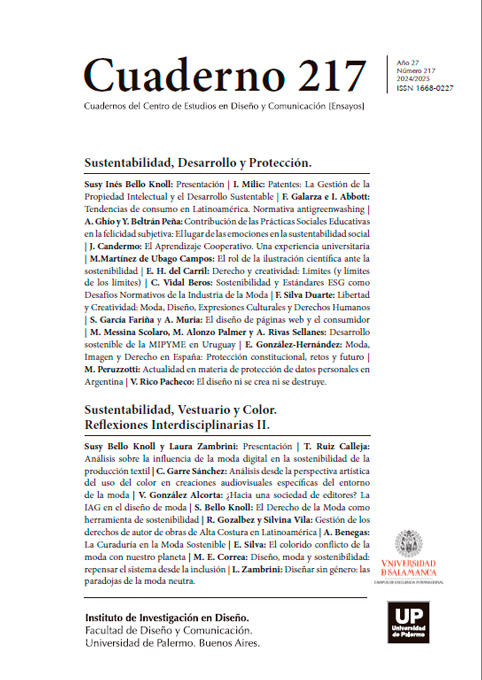El colorido conflicto de la moda con nuestro planeta
Résumé
Adentrándonos en la intrincada cadena textil, desvelamos el impacto ambiental de la coloración de fibras textiles y las limitaciones de los tintes sintéticos comerciales.
Références
Besegatto, S. V., Costa, F. N., Damas, M. S. P., Colombi, B. L., De Rossi, A. C., de Aguiar, C. R. L., & Immich, A. P. S. Enzyme treatment at different stages of textile processing: a review. Industrial Biotechnology, 14.6 (2018), 298-307.
Carneiro P. A. et al. “Assessment of water contamination caused by a mutagenic textile effluent/dyehouse effluent bearing disperse dyes”. Journal of Hazardous Materials, 174 (2010): 694-699.
Chequer, F. D., et al. “Textile dyes: dyeing process and environmental impact”. Eco-friendly textile dyeing and finishing 6. 6 (2013): 151-176.
Hill, D. J. Is there a future for natural dyes? Review of Progress in Coloration and Related Topics, 27.1 (1997): 18-25.
Iram, Liaqat. et al. “Changes in selected blood biochemical components of industrial workers occupationally exposed to textile dyes: a preliminary study”. Pakistan Journal of Zoology, 41 (2008): 65-69.
Islam, S. & Mohammad, F. “Emerging Green Technologies and Environment Friendly Products for Sustainable Textiles”. In Roadmap to Sustainable Textiles and Clothing, Textile Science and Clothing Technology; Muthu, S.S., Ed.; Springer: Singapore, 2014.
Jang, M. S., Jung, B. G., Sung, N. C., & Lee, Y. C. Decolorization of textile plant effluent by Citrobacter sp. strain KCTC 18061P. The Journal of general and applied microbiology, 53.6 (2007), 339-343.
Kant, R. “Textile dyeing industry: an environmental hazard”. Natural Science 4 (2012): 22-26. Zaruma, Pablo, et al. “Los colorantes textiles industriales y tratamientos óptimos de sus efluentes de agua residual: una breve revisión.” Revista de la Facultad de Ciencias Químicas 19 (2018): 38-47.
Kasiri, M. B, & Siyamak S. “Natural dyes and antimicrobials for green treatment of textiles.” Environmental chemistry letters 12.1 (2014): 1-13.
Lai, Peggy S., and David C. Christiani. “Long term respiratory health effects in textile workers.” Current opinion in pulmonary medicine 19.2 (2013): 152.
Lara, L., Cabral, I., & Cunha, J. Ecological approaches to textile dyeing: a review. Sustainability, 14.14 (2022), 8353.
Oliveira G. A. R. et al. “Chlorination treatment of aqueous samples reduces, but does not eliminate, the mutagenic effect of the azo dyes Disperse Red 1, Disperse Red 13 and Disperse Orange 1”. Mutation Research 703 (2010): 200-208.
Ramachandran, P., Sundharam, R., Palaniyappan, J., & Munusamy, A. P. Potential process implicated in bioremediation of textile effluents: a review. Adv Appl Sci Res, 4.1 (2013), 131-145.
Saus W, Knittel D, Schollmeyer E. Dyeing of textiles in supercritical carbon dioxide. Text Res J 63 (1993):135–142
Saxena, S. & A. S. M. Raja. “Natural dyes: sources, chemistry, application and sustainability issues.” Roadmap to sustainable textiles and clothing: eco-friendly raw materials, technologies, and processing methods. Singapore: Springer Singapore, 2014. 37-80.
Shen, J.; Smith, E. Enzymatic treatments for sustainable textile processing. In Sustainable Apparel—Production, Processing and Recycling; Blacknurn, R., Ed.; Woodhead Publishing: Sawston, UK, 2015; pp. 119–133.
Zille, A.; Oliveira, F.R.; Souto, A.P. Plasma treatment in textile industry. Plasma Process. Polym. 2014, 12, 98–131.
Los autores/as que publiquen en esta revista ceden los derechos de autor y de publicación a "Cuadernos del Centro de Estudios de Diseño y Comunicación", Aceptando el registro de su trabajo bajo una licencia de atribución de Creative Commons, que permite a terceros utilizar lo publicado siempre que de el crédito pertinente a los autores y a esta revista.


